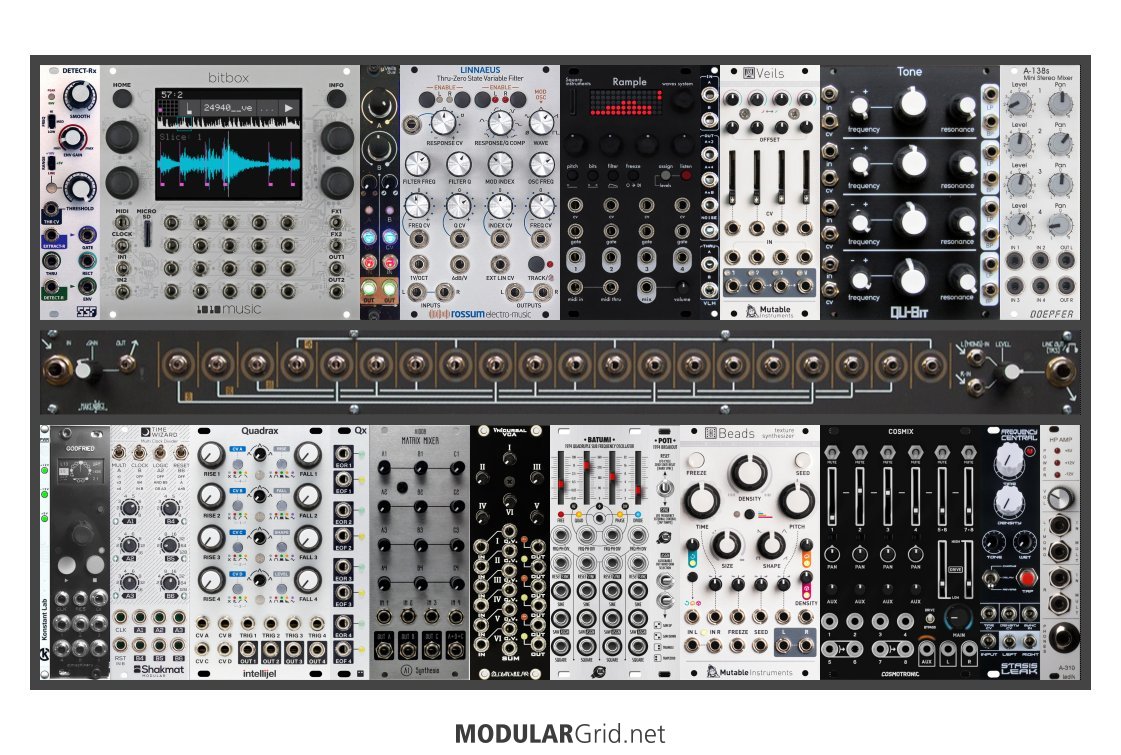Uhmmm...no. For one thing, you've added a case to two standalone devices, thereby increasing their cost. And why in god's name is there a pair of bog-standard VU meters taking up 24 hp here? As someone who's worked in concrete media as well as tape AND sampling systems for that sort of work, I can safely say that you do not need those.
OK, so if you're going to do a sample-based system, first up, it needs more in the way of modulation. You also have to figure out how to get both mono AND stereo samples to play nice in there. Plus, you can add more than just a single stereo voice. So, I cobbled up something that I, as someone who was chopping tape back in the late 1970s, would feel would be suitable as a concrete system. Ergo:

This build, in a Make Noise 7U cab, goes a long way toward that. You have an input and output (to TRS) on the mult bar, and with the top row's first module, you can extract dynamics information from an incoming source...which need not be mixed in with the rest of the audio if you just want the envelope follower as a modulator alone.
So, there's that, then a stereo sample module, the 1010 Bitbox, which has a dual VCA for level control after it and before it feeds into a Rossum Linnaeus stereo VCF. This filter also has the ability to do TZFM, so you can impose some VERY extreme filtering onto the Bitbox's output. From here, this would feed down to the mixer section so that it can either be manipulated further by the Beads or it can go directly to two mixer channels.
The second sampler chain uses a Squarp Rample, which has four mono outs. The little module next to it allows for ring modulation and some other mangling options (suboscillator is one of them), then you have a Veils for the four voices followed by a Qu-bit Quad VCF, and this feeds to a stereo submixer for spatialization and mixing. The mixer then goes to the mixer and/or Beads, as desired.
Now, for modulation, we start with a complex clock gen, then a hex clock divider. After this, a Quadrax/Qx setup provides four envelopes or, if desired, four looping envelopes. The Qx also allows the Quadrax to "cascade" these. Then, a matrix mixer; since this is a bit limited in mod sources, this allows the user to crossmix several mod sources so that up to four more "composite" modulation signals can be derived. The Zlob Vnicvrsal VCA then gives you six linear VCAs for even more modulation manipulation capability. As for LFOs, I put in a Batumi with the Poti expander for four LFO sources.
Then the mix/FX section. The Beads is Mutable's "mkii" version of the venerable Clouds module, with many granular methods of messing with audio, and this could conceivably be fed by either the first or second sampler chains, then sending the output to a pair of mixer channels. And as for that mixer, I specced out Cosmotronix's Cosmix, giving you four mono ins, two pair of stereo ins, an mono AUX bus and stereo FX return. And since the Cosmix has a mono out/stereo in for FX, I dropped in a Frequency Central Stasis Leak which has that same topology. This provides reverb, chorus, and a tap delay. Then the last module gives you a headphone amp with stereo passthru to the Make Noise's stereo out. On, and the little white sliver is a Konstant Labs PWRchekr; yeah, the Ladik headphone passthru has DC bus indicators, too...but the Konstant Labs one is mission-specific, whereas the Ladik's indicators are something of a "sideshow element" and not the module's main focus.
Now, THIS is a decent sample-based setup. It not only has several voices, but it adds all of the modulation devices you'd need to really make those voices go really bonkers. As someone who's spent years...literally...futzing around with splicing blocks and grease pencils, this build is how I'd rather approach sample manipulation: if you have to do it all in one "box", make sure the box has everything it needs already self-contained.
